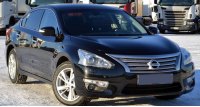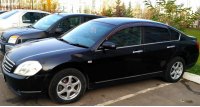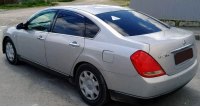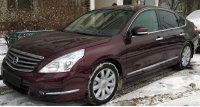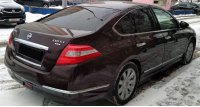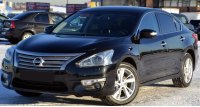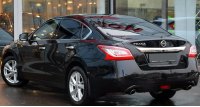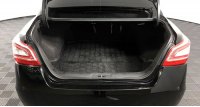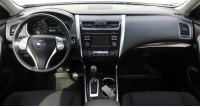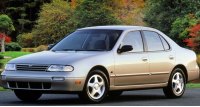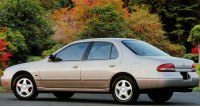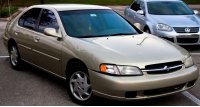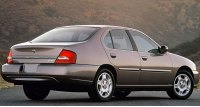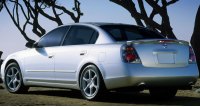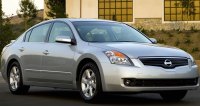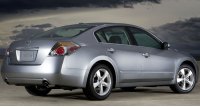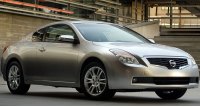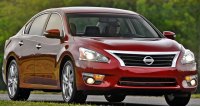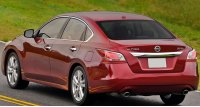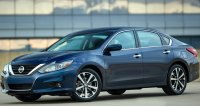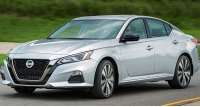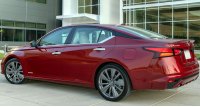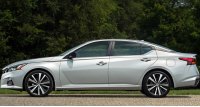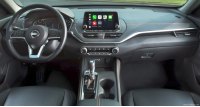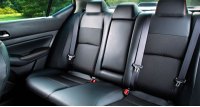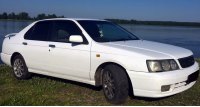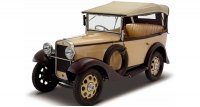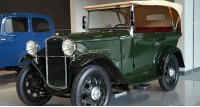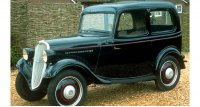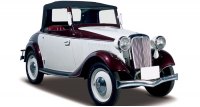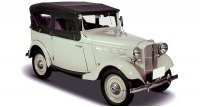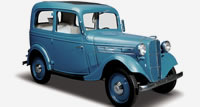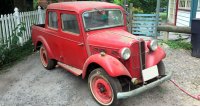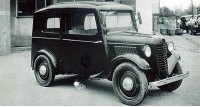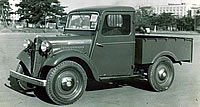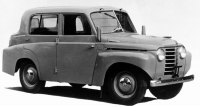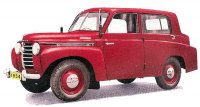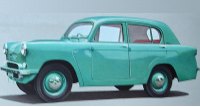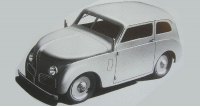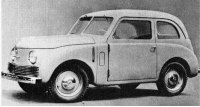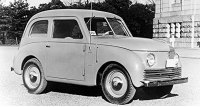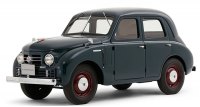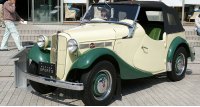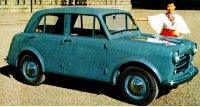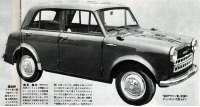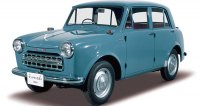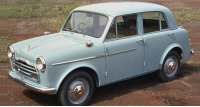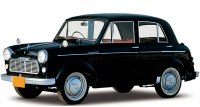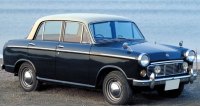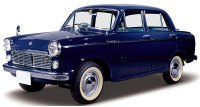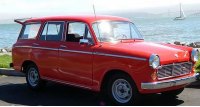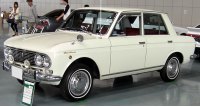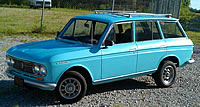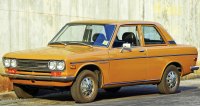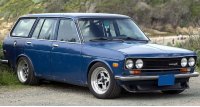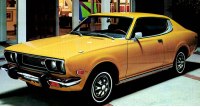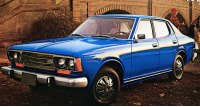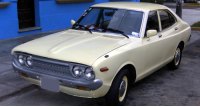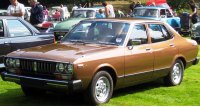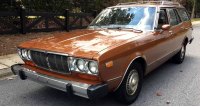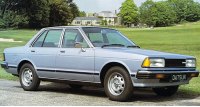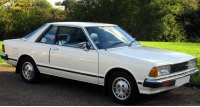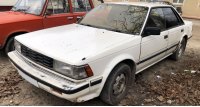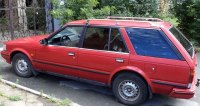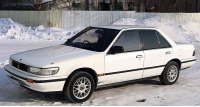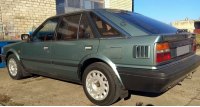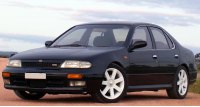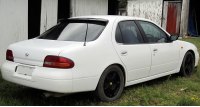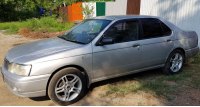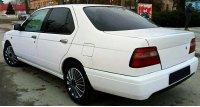Nissan Teana - middle class car (D-segment), produced from 2003 to the present by a Japanese automaker «Nissan Shatai Co., Ltd.». Name «Teana» originated from the village of the same name, located in southern Italy. Came to replace outdated cars «Bluebird», «Laurel» and «Cefiro». Exported to some countries under the names «Nissan Maxima» and «Nissan Cefiro». The body is a 4-door sedan with a front transverse engine. Drive is primarily through the front wheels, with all-wheel drive models also available. On all generations the gearbox is a continuously variable variator (CVT). The latest generation of the car is an updated version of the fourth generation «Nissan Altima».
The main competitors of this car are Audi A4, BMW 3, Chevrolet Malibu, Citroen C5, Ford Mondeo, Honda Accord, Hyundai Sonata, Kia Optima, Mazda 6, Mitsubishi Galant, Opel Insignia, Peugeot 508, Renault Laguna, Skoda Superb, Subaru Legacy, Toyota Camry and Volkswagen Passat.
First generation (J31, 2003–2008)
In February 2003, the first generation of the Teana sedan appeared in Japan with the code «J31» as a crossover companion «Nissan Murano». A month later, exports to other countries began, and sales in Europe began only in 2004. The car is based on a platform «Nissan FF-L», which is also the basis for «Maxima», «Altima», «Quest», «Presage» And others. The length of the car was 4770-4845 mm, width 1765 mm, height 1475-1495 mm and curb weight 1460-1540 kg. It is one of the largest sedans in the world with front-wheel drive. The car was assembled in Japan, China, Taiwan, Thailand and South Korea.
The engines were installed only with gasoline engines of the following characteristics - four-cylinder in-line with a volume of 2.0 liters (1998 cm3, QR20DE, I4, 134 hp.), as well as two six-cylinder V-shaped 2.3 liters (2349 cm3, VQ23DE, V6, 171 hp.) and 3.5 liters (3498 cm3, VQ35DE, V6, 241 hp). Torque is transmitted to the wheels through a variator «X-Tronic» (CVT). Trim levels based on engine size were called «200JK», «230JM» and «350JM».
In December 2005, the model was slightly updated. The headlights, taillights and fog lights were refreshed, and chrome trim appeared on the bumpers. The length of the car has decreased slightly.
Second generation (J32, 2008–2013)
Second generation with code «J32» was shown at the Beijing Auto Show in 2008. The design was based on a concept car «Intima», shown in October 2007. The car is based on a platform «Nissan D», which is used for «Altima», «Murano», «Maxima», «Elgrand», «Quest» and some other cars of the same time. Sold in the countries of the Middle and Far East, Oceania and Russia. In a number of countries it was called «Cefiro», In some «Maxima». Not sold in Europe, his classmates were there «Renault Laguna» and «Renault Latitude». The body was a 4-door sedan with a length of 4850 mm, a width of 1795 mm, a height of 1500 mm and a curb weight of 1480-1570 kg. The car was assembled in Japan, India, China, Iran, Malaysia, Russia, Taiwan and Thailand.
Engines were installed only with 2.0 liter petrol engines (1997 cm3, MR20DE, I4, 134 hp.), 2.5 liters (2488 cm3, QR25DE, I4, 165 hp.), 2.5 liters (2495 cm3, VQ25DE, V6, 183 hp.) and 3.5 liters (3498 cm3, VQ35DE, V6, 249 hp). Transmission only continuously variable variator (CVT).
In 2011, the car underwent a minor update.
Third generation (L33; 2013–present time)
In 2013, the third generation of Teana was introduced in China. This car is similar to the fifth generation «Altima», which is sold in North America and has the same code «L33». In 2014, assembly for the Russian market was established at the plant in St. Petersburg. In December 2015, production in Russia was stopped. The car is based on a platform «Nissan D». The body is a 4-door sedan with a length of 4863 mm, a width of 1830 mm, a height of 1482 mm and a curb weight of 1514 kg.
There were only two 2.5 liter petrol engines (2488 cm3, I4, 173 hp.) and 3.5 liters (3498 cm3, V6, 249 hp). The transmission is continuously variable - CVT.
Predecessor - Nissan Altima
Nissan Altima - mid-size passenger car (since 2001), which is produced by a Japanese company «Nissan Motor» from 1992 to present. From the beginning of production until 2001, it was classified as a compact car. Is a direct continuation of the model «Bluebird», description of which see below. From the first to the fourth generation, it was produced only in the USA and sold on the American continents, the Middle East and Australia. In other markets the car was called «Teana». Until 2012, the Altima was slightly smaller than the Teana, and after that both cars became almost identical with a common chassis code «L33».
Name «Altima» was originally applied to the top trim line «Nissan Leopard», sold in the Japanese market from 1986 and then to a mid-size car «Nissan Laurel», sold in Central America until 1992. In 1992 «Nissan» stopped production «Stanza», who was a clone «Bluebird», replacing it with American «Altima».
First generation (U13, 1992–1997)
The first generation was the export version «Bluebird» eleventh generation with common chassis code «U13». Styling was developed by a Californian design team «Nissan». The very first official name of the car was «Stanza Altima», which was written in early instruction manuals. 1993 models can be seen with the inscription «Stanza» in small letters to the right of the ALTIMA emblem on the trunk lid. The body was a 4-door sedan with front-wheel drive and a length of 4585 mm, a width of 1704 mm, and a height of 1420 mm.
The engine was installed only with a 2.4-liter four-cylinder petrol engine (2389 cm3, KA24DE, I4, 150 hp.). Transmission: 4-speed automatic or 5-speed manual.
The suspension consisted of struts with anti-roll bars at both ends and was praised for its sporty and satisfying handling. The salon could accommodate four adults quite comfortably. There were four levels of finishing - «XE», «GXE», «SE» and «GLE». All cars except «XE», had electric windows.
Second generation (L30, 1997–2001)
The second generation design was also developed in the Californian design center «Nissan» under the direction of Doug Wilson. The body is also in the form of a 4-door sedan with a length of 4661 mm (before 1999) and 4719 mm (from the year 2000), width 1755 mm, height 1420 mm. The engine was located transversely at the front, drive to the front wheels. There were also four trim levels - «XE», «GXE», «SE» and «GLE».
The engine remained from the previous generation with a volume of 2.4 liters (2389 cm3, KA24DE, I4, 150 hp). The gearbox is also unchanged - 4-speed automatic or 5-speed manual.
In 1999, the car was updated for the 2000 model year. Inside, the front panel of the audio system has changed. The engine increased power from 150 to 160 horsepower. Gear ratios have been shortened on both transmission options, the anti-roll bars have been thickened, and the steering has been strengthened. The external dimensions of the body have become slightly longer, the design of the radiator grille, headlights and lights has been changed.
Third generation (L31, 2001–2006)
The third generation appeared in August 2001 as a 2002 model. It was the first car built on the new platform «Nissan FF-L», which was unique to North America. Asian «Teana» similar, but not exactly identical «Altima», was developed for the requirements of the Southeast Asian market. The body is traditionally a 4-door sedan with front-wheel drive, length 4864-4884 mm, width 1788 mm, height 1471 mm. The car was well received by the press, with critics praising the increased interior volume and engine power, all of which significantly increased demand for this family sedan.
Gasoline engines now available in two 2.5-liter models (2488 cm3, QR25DE, I4, 175 hp) and 3.5 liters (3498 cm3, VQ35DE, V6, 240-260 hp). The transmission is 5 or 6 speed manual, as well as 4 or 5 speed automatic.
In 2005, the model was updated. The body length was increased slightly, and the car also received a new front grille, all-red taillights, an updated interior and an optional DVD-based navigation system. The V6 engine's output is also slightly increased.
Fourth generation (L32A, 2006–2012)
Fourth generation with code «L32A» was shown on April 12, 2006 at the New York International Auto Show. The car is based on a platform «Nissan D» with new front and upgraded rear suspension. Since 2009 «Maxima», «Murano» and «Teana» also used this platform. The interior space and exterior dimensions have remained almost unchanged. The body was a 4-door sedan, 4821-4844 mm long, 1796 mm wide, 1471 mm high. For the first time a 2-door coupe body with a code appeared «D32» length 4595-4636 mm, width 1796 mm, height 1405-1420 mm. The curb weight of the car was 1442-1492 kg.
Engines were installed only with gasoline engines of the following characteristics - 2.5 liters (2488 cm3, QR25DE, I4, 175 hp) and 3.5 liters (3498 cm3, VQ35DE, V6, 270 hp). The gearbox is a 6-speed manual, as well as a continuously variable CVT.
The car was equipped with modern technologies such as «Smart Key», «Bluetooth» for mobile phones, rear view camera, etc. The instrument panel has been designed with large buttons for convenience. In 2008, ABS with electronic brake force distribution began to be installed.
An update was carried out in 2009 for the 2010 model year. The car received a new front panel, hood, headlights, rims, as well as new interior materials. Electronic Stability Control, previously offered only as an option, is now standard on all trims.
Two-door coupe (code D32) was shown separately at the 2006 Los Angeles Auto Show and production began in May 2007. In 2009, a facelift was carried out, which included an updated front end, hood, grille and headlights.
In February 2007, a hybrid car was introduced «Altima Hybrid», which was launched in 2011. The hybrid had a 2.5 liter petrol engine (2488 cm3, QR25DE, I4) 158 hp, and the electric motor produces an additional 40 hp, developing a maximum power of 198 hp.
Fifth generation (L33, 2012–2018)
In April 2012, at the New York International Auto Show, the fifth generation Altima with code «L33». Production began in May 2012 as a 2013 model. The car uses the platform «Nissan D». The only body left was a 4-door sedan with a length of 4859 mm, a width of 1829 mm, a height of 1471 mm and a curb weight of 1430-1530 kg. Production of the coupe was discontinued. Most of the exterior styling is taken from «Maxima A35». Most of the main mechanical components were carried over from the previous generation. This car is identical to the third generation «Teana» and has the same chassis code «L33».
The range of gasoline engines expanded significantly and included the following models - 1.6 liters (1618 cm3, MR16DDT, I4, turbo, 190 hp), 2.0 liters (1997 cm3, MR20DE, I4, 136 hp), 2.5 liters (2488 cm3, QR25DE, I4, 182 hp) and 3.5 liters (3498 cm3, VQ35DE, V6, 270 hp). Also, for the first time, they began to install a 2.0-liter diesel engine (1995 cm3, M9R dCi, I4) 148 hp. Transmission - continuously variable variator (CVT).
In a 2012 comparison test conducted by the American magazine Motor Trend, «Altima» finished fourth out of six cars after first place Volkswagen Passat, second place Honda Accord and third place Ford Fusion. After this, the American magazine «Car and Driver» also carried out tests where «Altima» took third place out of four.
Cars for the 2016 model year have been updated quite a bit. It received new front and rear bumpers, headlights and taillights, redesigned front seats «Zero Gravity», steering wheel and center console. New noise-absorbing materials for the interior and a noise-absorbing windshield began to be used. Finally, the infotainment system has been improved for 2018 «NissanConnect», which added functions «Apple CarPlay» and «Android Auto Connectivity», as well as an improved user interface (UI).
Sixth generation (L34, 2018–present time)
In April 2018, the sixth generation Altima was presented at the New York International Auto Show with code «L34». Sales began in October 2018. The car is based on a platform «Nissan CMF C/D», which also serves as the basis for «Qashqai», «X-Trail», as well as some cars «Renault» — «Espace», «Kadjar», «Talisman», «Mégane», «Koleos» and «Scénic». The body is traditionally only a 4-door sedan with a length of 4874 mm, a width of 1829 mm, a height of 1468 mm and a curb weight of 1466 kg. In addition to front-wheel drive, all-wheel drive will be available for the first time. The car is offered in five trim levels: «S», «SR», «SV», «SL» and «Platinum».
There are two models of engines with a volume of 2.0 liters (1997 cm3, KR20DDET, I4, turbo, 248 hp) and 2.5 liters (2488 cm3, PR25DD, I4, 188 hp). All engines are connected to a continuously variable CVT transmission. All-wheel drive is available only on 2.5-liter engine models.
The car will have a system «Nissan Intelligent Mobility», which includes semi-autonomous driving «ProPilot Assist», Intelligent Around View Monitor, Automatic Emergency Braking with Pedestrian Detection and Intelligent Lane Keeping.
Predecessor - Nissan Bluebird
Nissan Bluebird - is a compact family car produced from 1955 to 2001 by a Japanese automobile manufacturer «Nissan Motor». Name «bluebird» translated into Russian as «Blue bird» or «songbird» and appeared only in 1957. This is a world-famous, recognized car, which over a long period of production has proven its reliability and durability. The body was produced in various versions - sedan, station wagon, coupe and hardtop. The engine was located transversely at the front. The drive was rear-wheel drive until the eighth generation, and after 1983 the car switched to front-wheel drive. Cars with all-wheel drive were also produced.
Bluebird originated from the company's very first cars «Nissan», dating back to the 1900s, and also became the progenitor of subsequent generations of family cars. From the first years of production, the car became a traditional competitor «Toyota Corona», which was widely used as a taxi. Export versions were sold under different names - «Datsun 510», «Datsun 180B» (with versions 160B and 200B) And «Datsun Bluebird». Trade name «Nissan Bluebird» began to appear around 1982, when the brand «Datsun» decided to refuse in favor «Nissan». Sold in the USA under the name «Nissan Stanza», which was replaced in 1992 «Nissan Altima», the description of which see above. Replaced in Europe «Primera» in the European Nissan line in 1990. A six-cylinder version called «Maxima» was released in the 1980s and became a separate model.
Predecessors - Datsun Type 10–17
Datsun Type 10 was an example of a small car built in 1931.
Datsun Type 11 1932 was a small car with a 495 cc inline four-cylinder side-valve engine producing 10 hp. and a three-speed gearbox. The drive was to the rear wheels. The body was of different types - sedan, coupe, phaeton, roadster and van. The length of the car was 2710 mm, width 1175 mm, curb weight 400 kg. It is believed that it is a copy of a British car «Austin Seven». A total of 150 cars were produced. At first the cars were called «Datson», that is «DAT's son». Abbreviation «DAT» formed from the letters of the surnames of the company's founders «Datsun» — Den, Aoyama and Takeuchi.
Datsun Type 12 was a small car produced by a corporation «Nissan» in 1933. Name «Datsun» used by DAT Corporation for its line of small cars to differentiate them from full-size cars and trucks. After DAT Corporation was acquired «Nissan», these cars continued to be produced and the name was retained. «Type 12» was basically similar to the previous one «Type 11», the body dimensions were completely identical, but had a larger engine - 748 cm3 with a power of 12 hp.
Datsun Type 13 began production in April 1934. Dimensions, body shapes and engine displacement were identical «Type 12». The only thing they added was a body in the form of a small truck. The most significant changes were in the external design - more chrome elements were added, the appearance became more modern. This model was the first to be exported to other countries. Small production was also established in Australia. In total, about 880 cars were produced.
Datsun Type 14 1935 design differed little from the previous model, but a new engine was installed «Type 7» - four-cylinder with side valves with a volume of 722 cm3 and a power of 15 hp, connected to the wheels through a three-speed manual gearbox. The dimensions of the body increased slightly and became 2800 mm long, 1200 mm wide, 1600 mm high. Since the word DAT turned out to be a Japanese word that translates to hare or rabbit, «Type 14» A chrome figurine of a jumping rabbit was installed on the radiator above the logo. The figure disappeared on subsequent generations of the car. The car was produced at a new plant «Nissan» in Yokahama and was assembled there entirely, unlike previous generations, for the construction of which subcontractors were involved. In total, about 3,800 cars were produced, 53 of which were exported.
Datsun Type 15 began production in May 1936 and it was a completely new body, which was significantly different from the previous one «Type 14». Its length increased greatly from 2800 mm to 3187 mm, its width was 1190 mm, and its height was 1600 mm. The body styles were as follows: sedan, coupe, roadster, van, phaeton, and also a small truck «Datsun 15T». The engine remained the same with a volume of 722 cm3, the power was slightly increased to 16 hp. Due to the increase in length, the space in the cabin has greatly increased. Due to the flaring conflict with China, various materials became scarce and chrome elements had to be almost abandoned. The radiator grille was painted to match the color of the car and was installed not at an angle, but almost vertically. Ventilation holes appeared on the hood. Bumpers began to be installed on all models.
Datsun Type 16 was put into production in April 1937. The mechanical part is identical to the previous model with the same engine and transmission. The body dimensions also remained the same, and the shapes remained as follows - sedan, coupe, roadster and phaeton. The hood design has also changed. The shortage of materials became increasingly serious for «Nissan» and interior decoration became simpler and cheaper. They also did not update the appearance of the truck and continued to produce «Datsun 15T».
Datsun Type 17 began production in April 1937 and became the last model in the line due to the war with China that began on July 7, 1937 and the transition to the production of equipment for military needs. Externally, the car remained the same with the exception of the radiator grille design. The engine remains the same (4-cylinder, 722 cm3, 16 hp), like the transmission (3-speed). The body styles were as follows: sedan, coupe, phaeton and roadster. An updated truck was also produced «Datsun 17T». At the end of 1938, production was completely stopped. On the site «Nissan» in company information «Fact File» There is a timeline where production of this line of passenger cars ends in January 1944.
Predecessors - Datsun DA/DB/DS/DC series
Datsun DA produced from November 1947 to mid-1948. On September 2, 1945, World War II ended, with Japan the loser. All the companies and factories in the country were in complete disarray, both financially and practically. Due to bombing, most production stopped in 1944. During the war, passenger cars were practically not produced. In 1946, the restoration of the factories and the development of a new model called «Datsun DA». It was a very simple car. The chassis was based on a truck «Datsun 17T», but with a new rough and angular body measuring 3150 mm long, 1330 mm wide, 1570 mm high and a curb weight of 520 kg. The engine remains the same from «Datsun Type 17» volume 722 cm3 and power 16 hp. The transmission is also the same three-speed. At the end of production, the body acquired a more rounded and smooth shape.
Datsun DS appeared in 1950 as a replacement for the series «DA». Also based on pre-war truck designs «Datsun 17T», originating from the British car «Austin Seven». The engine remained the same with a volume of 722 cm3, the power was increased to 20 hp. The transmission is three-speed manual. By 1950, the chrome shortage had been eliminated and the car once again began to shine with chrome parts. The external design was similar to pre-war models. The body was a 2-door sedan with a length of 3185 mm and a width of 1380 mm. There was also a modification to the truck and van. In 1951, a modification of the model called «Datsun DS-2». The design was completely redesigned and featured a completely new body, but the chassis remained from the pre-war truck. The length of the car with a sedan body was 3500 mm, width 1400 mm, height 1550 mm and curb weight 770 kg. Beginning with «DS-2» and then the series of cars was called «Datsun Thrift». In 1952 appeared «Datsun DS-4» and immediately gained a reputation as the most terrible car in the company «Datsun». The body was in the form of a four-door sedan with a length of 3750 mm, a width of 1458 mm, a height of 1535 mm and a curb weight of 930 kg. The engine and gearbox remain the same. In 1953 appeared «Datsun DS-5» with a modified design. The external dimensions and weight of the car have not changed. The most important innovation is the installation of an 860 cm3 engine3 (D10 SV) 25 hp, which increased the maximum speed from 72 to 78 km/h. Latest modification «Datsun DS-6» appeared in 1954 and had the name «Convar». The design was significantly different from its predecessors, becoming more modern and attractive. The body was only a four-door sedan. The engine and chassis remained the same from «DS-5». Production ended in December 1954 and was replaced by the series «Datsun 110».
Datsun DB was introduced in March 1948, unlike anything previously seen in Japan. It was the first modern car created «Nissan» from the beginning of World War II and it was a complete copy of an American car «Crosley» 1947. The only significant differences were the design of the grille, the length of the hood and the shape of the windshield. The dimension between the back of the hood and the windshield is shorter on the Datsun because they needed a longer engine bay to accommodate the engine «Type 7», coming from previous generations. The body was only a 2-door sedan with a length of 3150 mm, a width of 1330 mm, a height of 1570 mm and a curb weight of 520 kg. In 1949 «Nissan» redesigned the front of the car to make it look less like «Crosley». The new model was called «Datsun DB-2» and was produced until 1950. In 1951 the four-door was introduced «Datsun DB-4» (DB-3 designation was omitted) with a sedan, station wagon or van body, length 3850, width 1480 mm, height 1560 mm and curb weight 890 kg. The engine has been carried over from the previous model. In 1953 he was replaced «Datsun DB-5» with a four-door sedan body of the same dimensions. The most important thing about this car is the completely new engine. Four-cylinder in-line engine with a displacement of 860 cm3 (D10 SV) with a power of as much as 25 hp. Latest modification «DB» series appeared in 1954 with the title «Datsun DB-6». The body and engine remained unchanged, and a new four-speed gearbox appeared.
Datsun DC-3 a lightweight sports car with a roadster body with two doors, length 3150 mm, width 1360 mm, height 1450 mm and curb weight 750 kg. It first went on sale on January 12, 1952. Based on truck chassis of the time. The engine was 860 cm33 (D10) with side valves with a power of 25 hp, three-stage non-synchronous transmission, cable-actuated brakes. The maximum speed of the car was only 70 km/h. Only 50 cars were produced.
First generation (110/112/113, 1955–1957)
Datsun 110 went into production in January 1955 and is the first car in a line that would eventually become «Datsun Bluebird», a car that would become the basis of the entire line «Datsun» for decades to come. With minor changes, production continued until July 1959, when «Datsun 211». The car's design was quite modern for its time, especially compared to previous models «DB». In addition to the main 4-door sedan there were also a station wagon (W110), truck (120) and convertible (K110) with soft top. The length of the car was 3860 mm, width 1466 mm, height 1540 mm and curb weight 890 kg. The engine remained the same four-cylinder with a volume of 860 cm3 (D-10) with carburetor «Solex» 25 hp. The chassis and suspension were completely new. The electrical system was 6 volt.
Datsun 112 produced from December 1955 to May 1956. The body was almost the same as «110», but several changes were made to the exterior design. The dashboard has also been completely redesigned. The mechanical part remained without any changes. This car won the second prize in the field of industrial design «Mainichi» in 1956 for «fresh design, maneuverability and comfortable interior». The body was a 4-door sedan, as well as a station wagon (W112) and a truck (122).
Datsun 113 produced from June 1956 to September 1957. Visually, the car is no different from the previous model. The only difference between «112» and new «113» - gearbox, but this is a very important change for the vehicle. Previously, a four-speed gearbox without synchronizers was used, which was a copy of the device used on «Austin A40 Somerset». On «113» a transmission of our own design was installed «Nissan», which was a 4-speed gearbox with synchronization in 2nd, 3rd and 4th speeds, and was also 10 kg lighter. Also, instead of a shift lever on the floor, the lever was moved to the steering column, as this allowed three people to sit in the front seat.
Second generation (210/211, 1957–1959)
Datsun 210 was put into production in October 1957 and continued until September 1958. Due to a strange marketing move, new «210» was released simultaneously with the new sedan «Datsun 114», which was a direct replacement for the previous one «Datsun 113», And «Datsun 210» entered the line as a more advanced version «114». The car design is almost identical «Datsun 113», the only differences are in the radiator grille, as well as the presence of steel side stripes. U «114» there were no side stripes. The chassis remains unchanged. The most important changes took place in the engine compartment. A new model engine was introduced «C» volume 988 cm3 with overhead valves (OHV) 37 hp, which was developed based on the engine of the series «Austin B». Thus, for the first time, a 12-volt electrical system began to be used instead of a 6-volt one. «Datsun 114», which continued to be released simultaneously with «210», continued to use the old engine «D-10». In addition to the 4-door sedan there was a station wagon (W210), ambulance (M210), commercial truck (220), as well as a cheaper sedan (114).
Datsun 211 was the last of the cars based on «Datsun 110» and the last small car produced before the name «Bluebird». Launched into production in October 1958 and discontinued in July 1959. It was produced simultaneously with the sedan «Datsun 115», which was a cheaper version and used an outdated side-valve engine. Technically «211» practically no different from «210», the differences were only in the external design. And also on the top versions they installed the engine of the model «E» volume 1189 cm3 power 48 hp.
Third generation (310/311/312, 1959–1963)
Datsun Bluebird 310 was put into production in August 1959 and continued until January 1961. Series «310» was an important milestone for both «Nissan», and for the Japanese auto industry as a whole. The name appeared «Bluebird», and the car marked the first time that a Japanese car manufacturer had created a modern and truly world-class car. By the end of the 1950s «Nissan» spent a lot of time and money installing the latest presses and processing equipment. By 1959, it was perhaps the most modern automobile assembly plant in the world. The quality of assembly and finishing of the car was the same as that of other cars, the cost of which was 2-3 times more. Engines have been used from «Datsun 211». The suspension was completely new, the door hinges were hidden inside the body. There were two body styles - a 4-door sedan and a station wagon (WP310). The length of the car was 3910 mm, width 1496 mm, height 1460 mm and curb weight 870 kg. With the advent of the model «310» sales «Nissan» went up quickly around the world and made the company the fifth-largest automaker in the world by the end of the 1960s.
Datsun Bluebird 311 put into production in November 1960 and stopped in August 1961. The appearance is almost identical to the previous model, with the exception of some details. There are badges on the back of the car «Datsun 1200» or «Datsun 1000», depending on what engine was installed. In addition to the sedan, a station wagon was offered (WP311). Engine model «C» with a volume of 988 cm3 was installed without changes, but they worked on the engine with a volume of 1189 cm3 and presented the model «E-1». It is paired with a new two-pin carburetor «Nikki» with a vacuum secondary system and produces 60 hp. Also, the engines have become even more reliable.
Datsun Bluebird 312 appeared in August 1962 and was the last modification of the third generation «Bluebird». The appearance and dimensions were practically no different from previous modifications. The most noticeable differences are a completely new grille design, the design of the rear lights has also been significantly changed, the side stripes on the body have been changed, a completely new dashboard and steering wheel. The engines used were the same ones «C-1» and «E-1». In September 1962, changes were made to the exterior design, which affected the grille and taillights. In September 1963, production ceased with the appearance of the series «410».
Fourth generation (410/411, 1963–1967)
Datsun Bluebird 410 appeared in September 1963, it was a quantum leap in automobile design and construction «Nissan». The company entered into a design contract with an Italian design house «Pininfarina», which was known for its collaboration with «Ferrari» and «Fiat». They came up with a very beautiful and very modern design. Compared to the previous model, the body «410» became load-bearing, abandoning the frame, which reduced weight and production costs. The body was a 4-door sedan, station wagon (WP410) and 2-door sedan (P410-R). The length of the car was 3995 mm, width 1490 mm, height 1390 mm and curb weight 885 kg. The engines were 4-cylinder petrol with a volume of 988 cm3 (C-1) 45 hp and 1189 cm3 (E-1) 60 hp. Both engines are overhead valves (OHV) with carburetors «Nikki». Gearbox moved from «312» series unchanged. There was also a more powerful car model «DP410-M Bluebird SS» with two carburetors «Hitachi» and engine power 65 hp. And «female» car variant «DP410-L Fancy DeLuxe». In September 1964, a series of cosmetic changes were carried out.
Datsun Bluebird 411 appeared in 1965. External design, dimensions and weight are almost identical «410», the difference on export cars was that the badge on the front bumpers was now printed in DATSUN block letters. The most important change occurred under the hood. The 988 cm3 engine was no longer used, leaving the 1189 cm3 with a power of 60 hp, and a new series engine also appeared «J» volume 1299 cm3 power 67 hp. In addition to the 4-door sedan there was a station wagon (WP411) and 2-door sedan (P411-R). There were also more powerful modifications with names «R411 Bluebird SSS» and «P411-U-MTK Bluebird SS».
Fifth generation (510, 1967–1972)
Series «510» appeared in August 1967 and went on sale in 1968 in most export markets. The car immediately became a bestseller. «Nissan» wanted to create a more affordable version of the car line «BMW 02 Series», launched in 1966. That is, the goal was to create a light, comfortable, controllable, dynamic family car and it was achieved. Design «Bluebird 510» was very modern for its time, it does not look archaic even today. The body was 2- and 4-door sedan, 2-door coupe (KB510), as well as a 4-door station wagon (WP510). The length of the car was 4120 mm, width 1560 mm, height 1405 mm and curb weight 915 kg.
Series of gasoline four-cylinder engines «J» passed from the previous generation, increased in volume and there were two models with a volume of 1.3 liters (1289 cm3, J13, 67 hp) and 1.5 liters (1471 cm3, J15, 76 hp). Completely new series engines have also appeared «L» volume 1.3 liters (1286 cm3, L13, 77 hp), 1.4 liters (1428 cm3, L14, 84 hp), 1.6 liters (1595 cm3, L16, 96 hp) and 1.8 liters (1770 cm3, L18, 105 hp). The gearbox was a 4-speed manual with synchronizers in all gears and was located on the floor next to the driver.
Sixth generation (610, 1971–1976)
In August 1971, production of the series began in Japan «610» and she got the name «Datsun Bluebird-U». According to the company «Nissan» letter «U» means «user-oriented», that is, the emphasis is on increasing the comfort of the car. The advertising campaign used the slogan «Bluebird U − Up You!». The car body design was made in «Coca bottle style», a fashionable trend at the time. The body is presented in the form of a 4-door sedan, 2-door coupe and 5-door station wagon. The total length of the car was 4215 mm, width 1600 mm, height 1415 mm and curb weight 1035 kg. Trim levels in Japan were STD (standard), GL (Grand Luxe), SSS (Super Sports Sedan) and DX (Deluxe).
The range of four-cylinder petrol engines remains only in the series «L» the following characteristics - 1.6 liters (1595 cm3, L16, 92 hp), 1.8 liters (1770 cm3, L18, 105 hp), 2.0 liters (1952 cm3, L20B, 110 hp). A 2.0-liter six-cylinder inline engine also appeared (1998 cm3, L20/L20A) 113 hp. The gearbox is 4- or 5-speed manual, and for the first time they began to install a 3-speed automatic.
The car received a facelift in 1974 with prominent turn signals on the front corners, a squarer grille and new tail lights. Inside, there's new equipment such as a remote trunk release, interval wipers, a central handbrake and new interior materials.
In January 1973 «Nissan» launched a new line of slightly smaller cars «Datsun 710» or «Datsun Violet», using details and designs from the series «610».
Seventh generation (810, 1976–1979)
In July 1976, the series was presented «810» car lines «Bluebird». The design was an evolution «610» series with straightened lines, but still retaining features «Coca bottles». The body was a 4-door sedan, 2-door coupe and 5-door station wagon. The overall dimensions of the car were: length 4260 mm, width 1631 mm, height 1389 mm and curb weight 1084 kg. The car was exported under the names «Datsun 160B», «Datsun 180B» and «Datsun 200B». In the Japanese market, cars featured NAPS badges on the rear, which signified the use of emission control technology.
The first two years used series engines «L» with the same characteristics and already used on the previous generation. Since 1978, they were replaced by a new series of four-cylinder gasoline engines of the series «Z» the following volumes - 1.6 liters (1595 cm3, Z16, 94 hp) and 1.8 liters (1770 cm3, Z18 - 103 hp, Z18E - 113 hp). The transmission remains unchanged - 4- and 5-speed manual or 3-speed automatic.
Eighth generation (910, 1979–1983)
The eighth generation was introduced in November 1979 «Datsun Bluebird». The design used simple and clean lines in contrast to its predecessor, made in the style «Coca bottles». The suspension, wheelbase and most of the engines remain the same. This is the last car in the line with rear-wheel drive. The body was a 4-door sedan, a 5-door station wagon and a 2-door coupe. The length of the sedan was 4351 mm, width 1656 mm, height 1402 mm and curb weight 1135 kg. Name «Maxima» appeared for the first time in this generation.
Gasoline engines series «L» were modified and had the following volumes - 1.6 liters (1595 cm3, L16S), 1.8 liters (1770 cm3, L18S), 1.8 liters (1770 cm3, L18T, 108 hp) and 2.0 liters (1952 cm3, L20B, 110 hp). Series engines «Z» represented by the following models - 1.6 liters (1595 cm3, Z16S), 1.8 liters (1770 cm3, Z18E, 113 hp) and turbocharged 1.8 liters (1770 cm3, Z18ET, 133 hp). A 2.0-liter petrol engine was offered in Australian markets (1974 cm3, CA20S, 102 hp) and a 2.0 liter diesel engine (1952 cm3, LD20, 64 hp).
Ninth generation (U11, 1983–1987)
In October 1983, a completely new car from a technical point of view was introduced. This was a change from rear wheel drive to front wheel drive. The design remains very similar to the previous generation. Because of this, the drag coefficient could not boast of success and amounted to 0.39, which was not a very good indicator for that time. The body was offered as a 4-door sedan, a sedan with a folding roof and a 5-door station wagon. The length of the car was 4360-4500 mm, width 1690 mm, height 1370-1430 mm and curb weight 1080-1215 mm. During the same period, the name was completely abandoned «Datsun» and the model began to be called «Nissan Bluebird».
The range of gasoline engines consisted of the following volumes - 1.6 liters (1598 cm3, CA16, I4, 80 hp), 1.8 liters (1809 cm3, CA18S/CA18DE, I4, 113/129 hp), 1.8 liters (1809 cm3, CA18ET/DET, turbo, I4, 133/164 hp), 2.0 liters (1973 cm3, CA20S/E, I4, 100 hp) and six-cylinder 2.0 liter (1998 cm3, VG20E/VG20ET, V6, 113/170 hp). There were two models of diesel engines, both with a volume of 2.0 liters (1952 cm3), one atmospheric (LD20, I4, 66 hp) and one turbocharged (LD20T, I4, 78 hp). Gearbox 4 or 5-speed manual, as well as 3 or 4-speed automatic.
Tenth generation (U12, 1987–1992)
In September 1987, the series was presented «U12» with a more modern, rounded design. The car also had other names - «Nissan Stanza» (North America), «Ford Corsair», «Nissan Pintara» (Australia), «Tan Chong Bluebird» and «Yue Loong Bluebird 941». The body was produced as a 4-door sedan and a sedan with a folding hardtop, as well as a 5-door hatchback. The length of the car was 4570 mm, and since 1992 4590 mm, width 1699 mm, height 1374 mm. The drive is mainly on the front wheels, and also for the first time on «Bluebird» began to use a mechanical all-wheel drive system called «ATTESA».
Gasoline engines for the most part moved from the previous generation with minor modifications and were the following models - 1.6 liters (1598 cm3, CA16S, I4, 80 hp), 1.8 liters (1809 cm3, CA18DE/CA18i, I4, 128/91 hp), 1.8 liters (1809 cm3, CA18DET/DET-R, turbo I4, 167 hp), 1.8 liters (1838 cm3, SR18Di, I4, 108 hp), 2.0 liters (1974 cm3, CA20E, I4, 105 hp), 2.0 liters (1998 cm3, SR20DE, I4, 128 hp), 2.0 liters (1998 cm3, SR20DET/DET-R, turbo, I4, 202 hp) and 2.4 liters (2389 cm3, KA24E, I4, 134 hp). There was one diesel engine with a volume of 2.0 liters (1974 cm3, LD4 II, I4, 64 hp). Transmission: 5-speed manual or 4-speed automatic.
Eleventh generation (U13, 1991–1997)
In September 1991, the next generation with the code was launched «U13». The exterior design has become even more modern and streamlined. The body is presented in the form of a 4-door sedan and hardtop (retractable hardtop) length 4585 mm, width 1695 mm, height 1405 mm and curb weight from 1070 to 1370 kg. The wheelbase has increased by 70 mm, which made the cabin more spacious and comfortable. To make passengers feel more comfortable on hardtop models, an active noise reduction system has been used. Drive is primarily front-wheel drive, with a few Japanese models equipped with all-wheel drive «ATTESA». The car was exported under the name «Nissan Altima» first generation with the same chassis code «U13» (see above on the page).
Gasoline engines have all been seriously updated - they all have two overhead camshafts (DOHC) and had the following volumes and characteristics - 1.6 liters (1597 cm3, GA16DS, I4, 89 hp), 1.8 liters (1838 cm3, SR18DE, I4, 123 hp), 2.0 liters (1998 cm3, SR20DE/EQ486, I4, 128 hp), 2.0 liters (1998 cm3, SR20DET, turbo, I4, 206 hp) and 2.4 liters (2389 cm3, KA24DE, I4, 155 hp). There was one diesel engine with a volume of 2.0 liters (1973 cm3, I4, 76 hp). Transmission: 5-speed manual or 4-speed automatic.
Twelfth generation (U14, 1996–2001)
Last generation «Nissan Bluebird» with code «U14» was released in January 1996. This generation was sold only in the Japanese domestic market. American «Altima» developed into a completely separate line of cars with new chassis series codes «L» (see above), and also a more powerful one was already produced in the USA «Maxima». In Europe it was replaced «Teana», appeared in 2003 (see above). The body was offered as a 4-door sedan with front-wheel drive or all-wheel drive. The length of the car was 4565 mm, width 1695 mm, height 1395 mm and curb weight from 1140 to 1330 kg.
The range of petrol engines now starts with a volume of 1.8 liters (1838 cm3, SR18DE, I4, 123 hp), then there are two 2.0 liter engines (1998 cm3, SR20DE, I4, 145 hp) And (1998 cm3, SR20VE, I4, 187 hp). There were also two diesel engines, one DOHC 1.8 liter (1769 cm3, QG18DE, I4, 115 hp), the other with a single camshaft of 2.0 liters (1973 cm3, CD20E, I4, 75 hp). Transmission: 5-speed manual, 4-speed automatic, as well as continuously variable variator (CVT).
Trim levels included standard «LeGrand», luxurious «Eprise», sports «SSS» and model «SSS-Z» limited edition.
